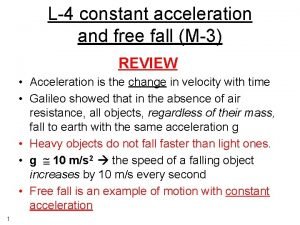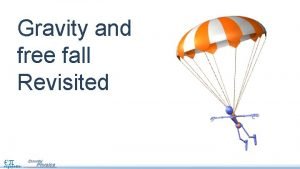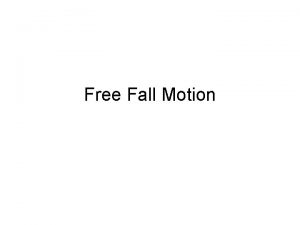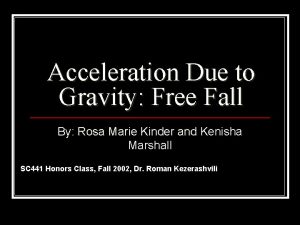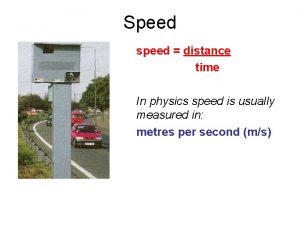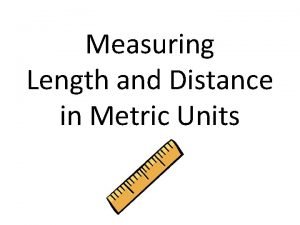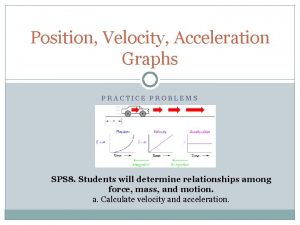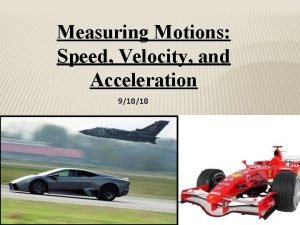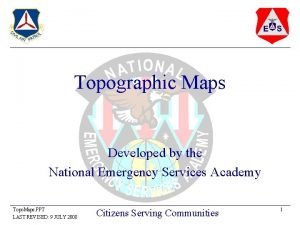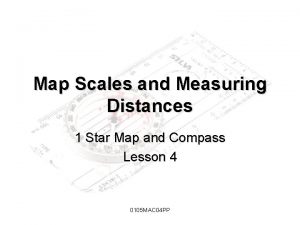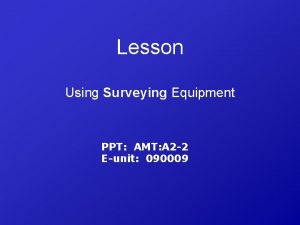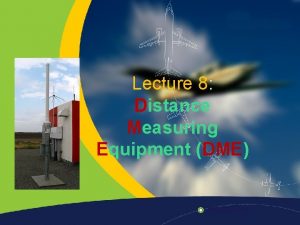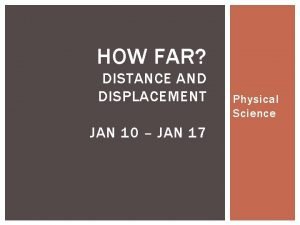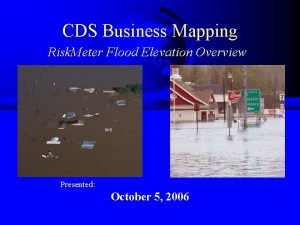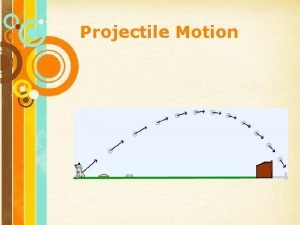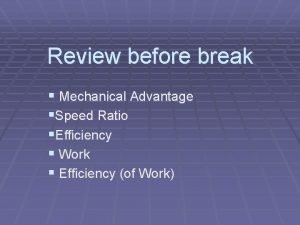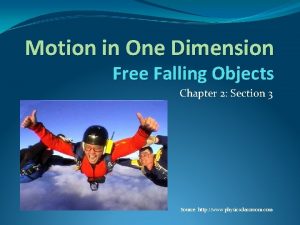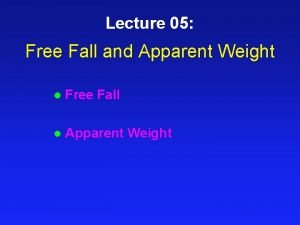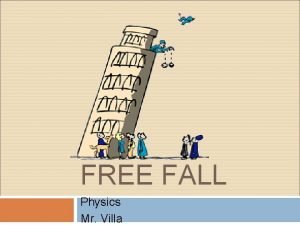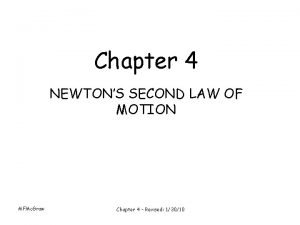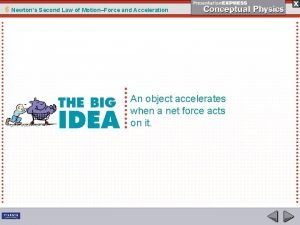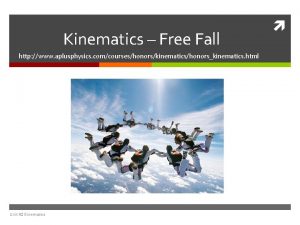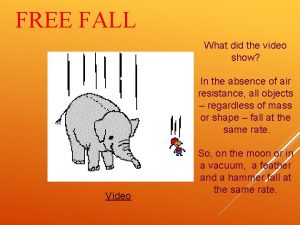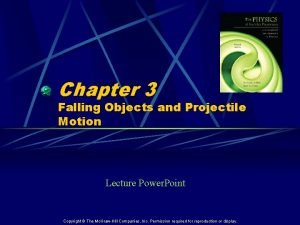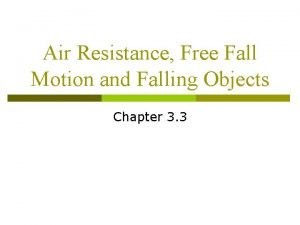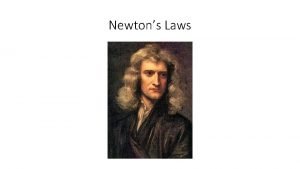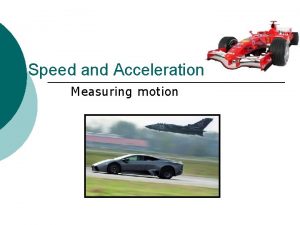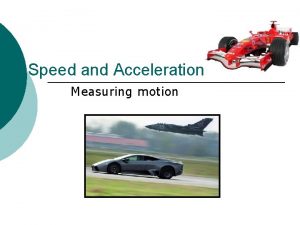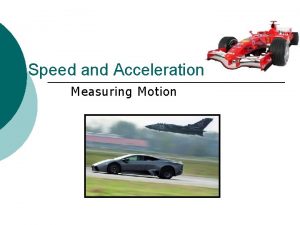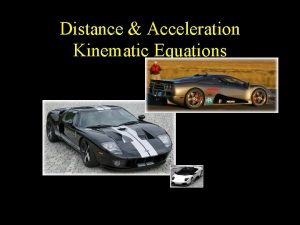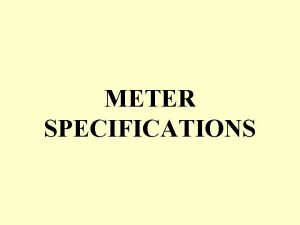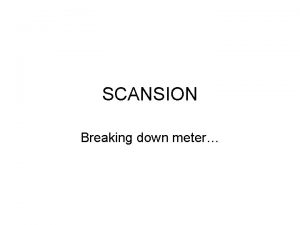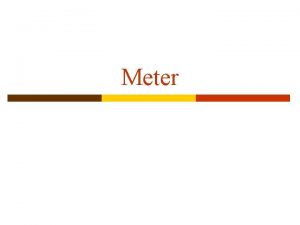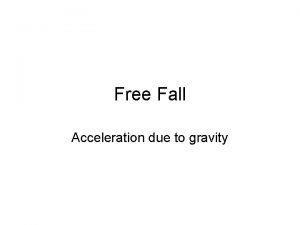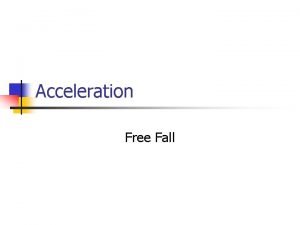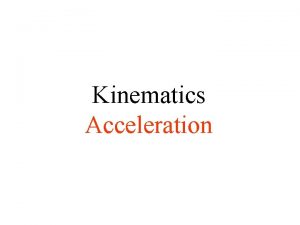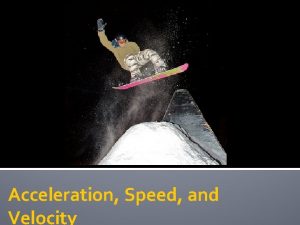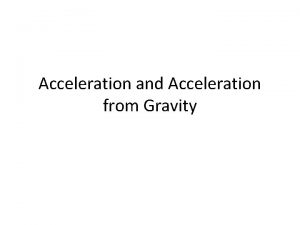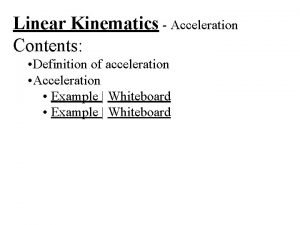Acceleration and Free fall 2016 Measuring Distance Meter




































- Slides: 36

Acceleration and Free fall 2016

Measuring Distance • Meter – international unit for measuring distance. 1 mm = 50 m

Calculating Speed • Speed (S) = distance traveled (d) / the amount of time it took (t). S = d/t

Average speed • Speed is usually NOT CONSTANT ▫ Ex. Cars stop and go regularly ▫ Runners go slower uphill than downhill • Average speed = total distance traveled/total time it took.

Calculating Average Speed Problem # 1 • It took me 1 hour to go 40 km on the highway. Then it took me 2 more hours to go 20 km using the streets. • Total Distance: ▫ 40 km + 20 km = 60 km • Total Time: ▫ 1 h + 2 h = 3 hr • Ave. Speed: ▫ total d/total t = 60 km/3 h = 20 km/h

Velocity • Velocity – the SPEED and DIRECTION of an object. ▫ Example: �An airplane moving North at 500 mph �A missile moving towards you at 200 m/s

Graphing Speed: Distance vs. Time Graphs Problem # 2 Denver Phoenix

Change in Velocity • Each time you take a step you are changing the velocity of your body. • You are probably most familiar with the velocity changes of a moving bus or car. • The rate at which velocity (speed or direction) changes occur is called acceleration.

Acceleration • The rate of change of velocity in a given time interval is acceleration. ▫ Formula aavg = Δv = vf - v i tf - t i average acceleration = Change in velocity. Time Required for Change Δt

Acceleration= final velocity- starting velocity time Change in velocity = final velocity vf – starting velocity vi Acceleration= change in velocity (Δv) time

Calculation Practice # 3 Betty the shuttle bus driver slows to a stop with an average acceleration of -1. 8 m/s 2. How long does it take the bus to slow from 9. 0 m/s to 0. 0 m/s? aavg = Δv = vf - vi Δt tf - t i vf = 0 m/s vi = 9. 0 m/s aavg = -1. 8 m/s 2 Δt = ? Δt=5. 0 s

Types of acceleration • Increasing speed ▫ Example: Car speeds up at green light • Decreasing speed screeeeech ▫ Example: Car slows down at stop light • Changing Direction ▫ Example: Car takes turn (can be at constant speed)

Acceleration +/ • Acceleration has direction and magnitude. • When velocity increases in the positive direction, acceleration increases. Ex. Train increasing speed as it leaves. • When velocity is constant, acceleration is zero. • When velocity in the positive direction is decreasing the acceleration is negative. Ex. Train slows as it approaches station.

Positive acceleration Negative acceleration

A constant acceleration produces a straight line or linear slope (rise/run). The slope of a nonlinear velocity-time graph (rise/run) will predict an objects instantaneous acceleration. a = v/t

Question # 4 • How can a car be accelerating if its speed is a constant 65 km/h? • If it is changing directions it is accelerating

Calculating Acceleration Problem # 5 Vf = 16 m/s Vi = 0 m/s t=4 s A=? 0 s 0 m/s 1 s 4 m/s 2 s 8 m/s 3 s 12 m/s 4 s 16 m/s

4 Kinematic Equations

Δx = displacement (final position – initial position) vf = velocity or speed final vi = initial velocity or speed t = time a = acceleration

Calculation Practice # 6 • Erica reaches a speed of 42 m/s. She then begins a uniform negative acceleration, using its parachute and brakes. She comes to rest 5. 5 s later. How far has the dragster traveled while stopping? vi = 42 m/s Δt = 5. 5 s vf = 0 m/s Unknown Δx = ? X = 115. 5 m

Galileo Galilei (1564 -1642) • Father of Kinematics (How) • Concluded that all objects fall at same rate of acceleration. • Demonstrated the scientific method in developing the kinematics of free fall motion. • Tested his hypothesis through experimentation. http: //www. youtube. com/watch? v=7 e. Tw 35 ZD 1 Ig

Galileo • He found that the distance depended on the square of the time and that the velocity increased as the ball moved down the incline. • The relationship was the same regardless of the mass of the ball used in the experiment.

https: //www. youtube. com/watch? v=V 6 xq g. WVg. Aok https: //www. youtube. com/watch? v=_m. CC -68 Ly. ZM An object in free-fall is only subject to the force of gravity (Neglect Air Resistance) (weight) https: //www. youtube. com/watch? v=Jz. KZ https: //www. youtube. com/watch? v=ur 40 O 6 n. QHsw Nm 1 lc. Dc

• Freely falling objects have constant acceleration. • This is only true with the absence of air resistance. • The free-fall acceleration is denoted with the symbol g 2 and is equal to 9. 8 m/s.

• Free Fall acceleration is directed downwards, toward the center of the Earth. • Since the downwards direction is negative, the acceleration due to gravity is also considered negative.

Since the acceleration of gravity is down, when in free-fall, ignoring air resistance: a=g= - 9. 8 m/s 2

• All objects, when thrown up will continue to move upward for some time, stop momentarily at the peak, and then change direction and begin to fall.



Freely Falling Body • Since accelerating objects are constantly changing their velocity, you can say that the distance traveled divided by the time taken to travel that distance is not a constant value. • A falling object for instance usually accelerates as it falls. • The fact that the distance which the object travels every interval of time is increasing is a sure sign that the ball is speeding up as it falls downward

-Which object hits the ground first? (ignore air friction) -Which object hits the ground first when we include air friction?

No Air Resistance With Air Resistance

Well, eventually, the force of air resistance becomes large enough to balance the force of gravity. At this instant in time the object stops accelerating. The object is said to have "reached a terminal velocity. "

In situations in which there is air resistance, massive objects fall faster than less massive objects. Why? Massive objects fall faster than less massive objects because they are acted upon by a larger force of gravity; for this reason, they accelerate to higher speeds until the air resistance force equals their gravity force. Basically the more massive object accelerates longer before reaching terminal velocity.

Practice #7 • A tennis ball is thrown vertically upward with an initial velocity of 8 m/s. What is the ball’s speed when it returns to the starting point? How long will it take? • Knowns? • a = -9. 8 m/s/s, vi = 8 m/s, vf(top) = 0 m/s, vitop = 0 m/s • Unknowns? • vf bottom= ? , t = ? • Equation? • Vf = vi +at • 0 = 8 + -9. 8 t, 8/-9. 8 =. 82 sec to top x 2 = 1. 6 s • Now vitop = 0 m/s and vfbottom = ? ; vfbottom = 0 + (-9. 8). 82 = -8 m/s

Practice # 8 • #4. Stephanie hits a volleyball from a height of. 8 m and gives it an initial velocity of 7. 5 m/s straight up. How high will the ball go? How long will it take to get to that height? • Knowns? • Vi = 7. 5 m/s, vf = 0 m/s, a = -9. 8 ms/s/s • Unknowns? • X = ? , t = ? • Equation? • Vf = vi +at • 0 = 7. 5 +(-9. 8 t); t =. 76 s • X =. 5(vi+vf)t =. 5(7. 5). 76 = 2. 85 +. 8 = + 3. 65 m
 Example of acceleration
Example of acceleration Free fall acceleration
Free fall acceleration Free fall acceleration
Free fall acceleration Free fall acceleration
Free fall acceleration Free fall conclusion
Free fall conclusion What is the acceleration of free fall
What is the acceleration of free fall Free fall 2016
Free fall 2016 Angular quantities
Angular quantities Kinetic angular energy
Kinetic angular energy Centripetal acceleration tangential acceleration
Centripetal acceleration tangential acceleration Circular acceleration
Circular acceleration Radial acceleration
Radial acceleration Distance speed time
Distance speed time Distance speed time
Distance speed time Finding metric length
Finding metric length Tekanan zat padat terkecil terjadi pada gambar bentuk
Tekanan zat padat terkecil terjadi pada gambar bentuk Position velocity acceleration graphs practice
Position velocity acceleration graphs practice Velocity acceleration distance formula
Velocity acceleration distance formula Measuring distance map
Measuring distance map Conventional symbols for class 6
Conventional symbols for class 6 Surveying instruments and their uses ppt
Surveying instruments and their uses ppt How dme works
How dme works What is the difference between distance and displacement
What is the difference between distance and displacement Riskmeter flood zone
Riskmeter flood zone Projectile motion powerpoint
Projectile motion powerpoint Bs 5266-1:2016 free download
Bs 5266-1:2016 free download The ratio of input distance to output distance
The ratio of input distance to output distance Free fall formula
Free fall formula Apparent weight example
Apparent weight example Gravitational acceleration
Gravitational acceleration Newton's second law
Newton's second law Law of force and acceleration
Law of force and acceleration Aplusphysics ucm gravity answer key
Aplusphysics ucm gravity answer key Free fall video
Free fall video Free fall upward motion
Free fall upward motion Air resistance on earth
Air resistance on earth At the end of the giant drop free fall
At the end of the giant drop free fall
